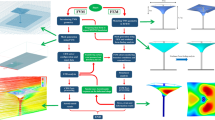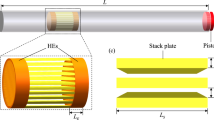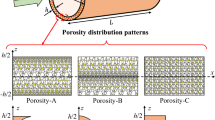Abstract
The squeeze film behavior of MEMS torsion mirrors is modeled, analyzed and discussed. Effects of gas rarefaction (first-order slip-flow model with non-symmetric accommodation coefficients, ACs) and surface roughness are considered simultaneously by using the average Reynolds type equation (ARTE). Based on the operating conditions with small variations in film thickness and pressure, the ARTE is linearized. A coordinate transformation, by stretching or contracting the axes by referring to the roughness flow factors, is proposed to transform the linearized ARTE into a diffusion type modal equation. The dynamic coefficients (stiffness and damping coefficients) are then derived and expressed in analytical form. The results show that the tilting frequency (or Γ0 squeeze number), roughness parameters (γ Peklenik numbers, σ standard deviation of composite roughness) and gas rarefaction parameters (D inverse Knudsen number, \(\alpha_{1}, \alpha_{2}:\) ACs) are all important parameters on analyzing the dynamic performance of MEMS torsion mirrors.







Similar content being viewed by others
References
Andrews M, Harris I, Turner G (1993) A comparison of squeeze-film theory with measurements on a microstructure. Sens Actuators A 36:79–87
Ausman JS (1967) Gas squeeze film stiffness and damping torques on a circular disk oscillating about its diameter. ASME J Lubr Technol 89:219–221
Bao M, Yang H, Yin H, Sun Y (2002) Energy transfer model for squeeze-film air damping in low vacuum. J Micromech Microeng 12:341–346
Blech JJ (1983) On isothermal squeeze films. ASME J Lubr Technol 105:615–620
Bhushan B, Tonder K (1989a) Roughness-induced shear and squeeze film effects in magnetic recording—part I: analysis. ASME J Tribol 111:220–227
Bhushan B, Tonder K (1989b) Roughness-induced shear and squeeze film effects in magnetic recording—part II: applications. ASME J Tribol 111:228–237
Burgdorfer A (1959) The influence of the molecular mean free path on the performance of hydrodynamic gas lubricated bearings. ASME Journal of Basic Engineering 81:94–100
Chang K-M, Lee S-C, Li S-H (2002) Squeeze film damping effect on a MEMS torsion mirror. J Micromech Microeng 12:556–561
Christian RG (1966) The theory of oscillating-vane vacuum gauges. Vacuum 16:175–178
Darling RB, Hivick C, Xu J (1998) Compact analytical modeling of squeeze film damping with arbitrary venting conditions using a Green’s function approach. Sens Actuators A 70:32–41
Griffin WS, Richardson HH, Yamanami S (1966) A study of squeeze film damping. ASME J Basic Eng 88:451–456
Finger GW, Kapat JS, Bhattacharya A (2007) Molecular dymamics simulation of adsorbent layer effect on tangential momentum accommodaton coefficient. ASME J Fluids Eng 129:31–39
Fukui S, Kaneko R (1990) A database for interpolation of Poiseuille flow rates for high Knudsen number lubrication problems. ASME J Tribol 112:78–83
Hornbeck LJ Digital Light Processing™ for high-brightness, high-resolution applications. http://www.vxm.com/TIDLP.html
Hsia Y, Domoto GA (1983) An experimental investigation of molecular rarefaction effects in gas-lubricated bearings at ultra-low clearances. ASME J Lubr Technol 105:120–130
Huang W, Bogy DB (2000) The effect of the accommodation coefficient on slider air bearing simulation. ASME J Tribol 122(2):427–435
Hutcherson S, Ye W (2004) On the squeeze-film damping of micro-resonators in the free-molecule regime. J Micromech Microeng 14:1726–1733
Hwang C-C, Fung R-F, Yang R-F, Weng C-I, Li W-L (1996) A new modified Reynolds equation for ultra-thin film gas lubrication. IEEE Trans Magn 32(2):344–347
Jang J, Wereley ST (2006) Effective heights and tangential momentum accommodation coefficients of gaseous slip flows in deep reactive ion etching rectangular microchannels. J. Micromech Microeng 16:493–504
Kang S-C (1997) A kinetic theory description for molecular lubrication. Ph.D. thesis, Carnegie Mellon University
Karniadakis GE, Beskok A (2002) Micro flows: fundamentals and simulation. Springer Berlin
Kim K-J, Lee C-W (2005) Dynamic characteristics of sealed squeeze film damper with a central feeding groove. ASME J Tribol 127:103–111
Kim E-S, Young-Ho Cho, Kim M-U (1999) Effect of holes and edges on the squeeze film damping of perforated micromechanical structures. Micro Electro Mechanical Systems 1999 (MEMS’99). Twelth IEEE international conference on, pp 296 –301
Langlois WE (1962) Isothermal squeeze films. Q. Appl. Math 20:131–150
Li W-L (1999) Analytical modeling of ultra-thin gas squeeze film. Nanotechnology 10(4):440–446
Li W-L (2002) A database for Couette flow rate—consideration of the effects of non-symmetric molecular interactions. Trans ASME J Tribol 124:869–873
Li W-L (2003) A database for interpolation of Poiseuille flow rate for arbitrary Knudsen number lubrication problems. J Chin Inst Eng 26(4):455–466
Li W-L (2004) Modeling of head/disk interface—an average flow model. Tribol Lett 17(3):669–676
Li G, Hughes H (2000) Review of viscosity damping in micro-machined structures. Proc SPIE 4176:30–46
Li W-L, Weng C-I (1997) Modified average Reynolds equation for ultra-thin film gas lubrication considering roughness orientations at arbitrary Knudsen numbers. Wear 209:292–300
Lord RG (1976) Tangential momentum accommodation coefficients of rare gases on polycrystalline metal surfaces. In: Rarefied gas dynamics, 10th symposium, Plenum, New York, pp 531–538
Minikes A, Bucher I, Avivi G (2005) Damping of a micro-resonator torsion mirror in rarefied gas ambient. J Micromechan Microeng 15:1762–1769
Mitsuya Y (1993) Modified Reynolds equation for ultra-thin film gas lubrication using 1.5-order slip-flow model and considering surface accommodation coefficient. ASME J Tribol 115:289–294
Pan F, Kubby J,Peeterst E, Trant AT, Mukherjee S (1998) Squeeze film damping effect on the dynamic response of a MEMS torsion mirror. J Micromech Microeng 8:200–208
San Andreś L, De Santiago O (2004) Forced response of a squeeze film damper and identification of force coefficients from large orbital motions. ASME J Tribol 126:292–300
Starr JB (1990) Squeeze-film damping in solid-state accelerometers, solid-state sensor and actuator workshop, 1990. 4th Techmical digest., IEEE, pp 44–47
Suciu CV, Bonneau O, Brun-Picard D, Frêne J, Pascovici MD (2000) Study of a novel squeeze film damper and vibration generator. ASME J Tribol 122:213–218
Veijola T, Kuisma H, Lahdenpera J (1997) Report CT-29, circuit theory laboratory, Espoo, Helsinki University of Technology
Veijola T, Kuisma H, Lahdenpera J, Ryhanen T (1995) Equivalent-circuit model of the squeezed gas film in a silicon accelerometer. Sens Actuators A 48:239–248
Acknowledgments
Te authors would like to thank for the financial support from National Science Council, Taiwan, contract number: NSC94-2622-E-151-004-CC3.
Author information
Authors and Affiliations
Corresponding author
Rights and permissions
About this article
Cite this article
Li, WL. Squeeze film effects on dynamic performance of MEMS μ-mirrors-consideration of gas rarefaction and surface roughness. Microsyst Technol 14, 315–324 (2008). https://doi.org/10.1007/s00542-007-0479-x
Received:
Accepted:
Published:
Issue Date:
DOI: https://doi.org/10.1007/s00542-007-0479-x




